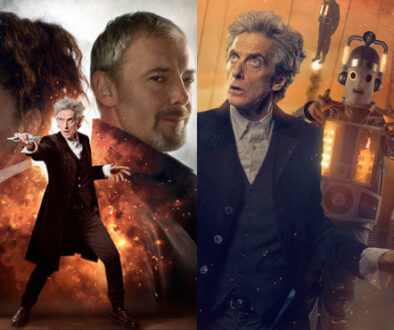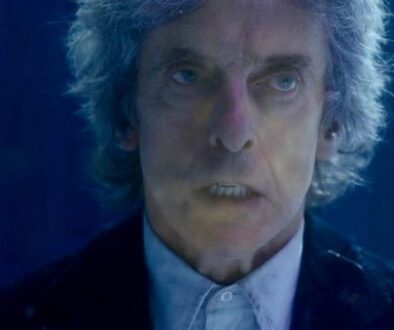Series 10: Oxygen Review
Clint Hassell gives his verdict on the fifth episode of Doctor Who Series 10.

Note: this review contains full spoilers for episode 5 of Series 10.
Modern Doctor Who has often imbued common items and occurrences with malice, pleading with viewers to not blink at the Weeping Angels, look away from the Silents, think about the Kantrofarri, or breathe in the presence of Clockwork Droids. Jamie Mathieson’s near-perfect script for “Oxygen” adds “don’t panic” to that list, as it expertly continues Series 10’s practice of recycling plot points from previous stories to craft an excellent “base under siege” episode of Doctor Who.
The episode’s opening teaser utilizes sweeping camera work and contrasting atmospheric lighting to create a harsh sense of outer space that is reminiscent of recent blockbuster films, like 2013’s Gravity. While the teaser’s plot is standard – – of course, the woman who has just confessed her love and revealed plans for her future is killed – – it is impeccably designed, and belies Doctor Who’s television budget. More impressively, the teaser is followed by a tightly edited post-credits montage that shows the Doctor growing weary of his confinement to Earth. Having shunned his TARDIS, he busies himself by giving off-topic lectures and ignoring lessons on responsibility from Nardole.

It is at this point that “Oxygen” subtly considers Bill’s tenure as companion, and thus the nature of her character. Despite having known the Doctor for at least two semesters, the series indicates that – – due to the Doctor’s duties as guardian of the vault, and evidenced by the Doctor’s increasing boredom – – Bill has only made one proper trip through spacetime. The Doctor seems to want to correct this, offering to take her “camping” in space – – a thinly veiled attempt to investigate the distress call emanating from the Chasm Forge. Why, having been shown the wondrous opportunities inherent to traveling in the TARDIS, does Bill seem content merely to audit the Doctor’s lectures and visit with him, after hours, in his office? In Series 7, Clara remained on Earth to care for the Maitland children, and in Series 8, her part-time companion status allowed Danny Pink and students from the Coal Hill School to be a part of the narrative; however, Bill has been given no compelling supporting cast of her own. Could it be that the Doctor chooses Bill as a companion, not just because her humanity balances out his and Nardole’s alien nature – – a characteristic that could be said of any random student from one of the Doctor’s lectures – – but because Bill is quietly complacent in her unexciting life on Earth? Perhaps the Doctor is wanting to learn from Bill, as he gives himself over to his mundane existence as guardian of the vault?
In fact, “Oxygen” seems to go out of its way to demonstrate that, perhaps, Bill does not yet have the capacity to be an effective companion, as the Doctor lectures her that, “The Universe shows its true face when it asks for help, and we show ours by how we respond. Any questions? Good,” without giving her any time to voice her obvious doubts. This isn’t a criticism – – note that neither Mickey nor Donna were ready to be companions when they first met the Doctor – – rather, it is further evidence that Bill and the Series 10 story arc were created synergistically, each informing the other, leading to a multi-layered companion so specifically tailored to these episodes that it is difficult to imagine Bill having appeared in a different series.

Despite the compelling examination of her character in the first act, Bill’s “death” in the second act is narratively unsatisfying. Knowing that Bill appears in the rest of Series 10, it is difficult to feel that she is truly in peril, despite how expertly portrayed and edited the scene of her asphyxiating is. While there is a way to tease the audience with a character’s fate – – Clara’s death in “Face the Raven” being a recent example – – in today’s age of pre-release publicity photos, synopses, and trailers, why do writers continue to utilize a transparent twist that is more “ploy” than “plot.” Worse, Mathieson attempts this ruse again in the third act, in a scene that fails to recreate the betrayal Clara felt as she was seemingly abandoned by the newly-regenerated Twelve, in “Deep Breath.”

The other minor problem within “Oxygen” is the Doctor’s blindness. The episode does little to explain how the vacuum of space led to the Doctor’s condition, which seems counter to his barely-protected plummet to Earth in “The Doctor, the Widow and the Wardrobe.” An explanation was especially necessary considering the concept of regeneration was teased in last week’s “Knock Knock.” While a helmet-less spacewalk is ostensibly easier to survive than some of the other things proven deadly to the Time Lord – – massive amounts of radiation, falling from a great height, and vivisection come to mind – – it is certainly more deadly than the “space turbulence” that killed Six, or the, um, “epic weariness” that forced the regeneration of the War Doctor.
It is evident that the Doctor’s blindness is necessitated by the plot of next week’s episode, “Extremis” – – the Doctor will be immune to the deadly effects of the book because he cannot see it – – the trade-off being that, for accommodating its inclusion, Mathieson gets an epic cliffhanger for his script’s epilogue. This is not a fair trade, however, as so little is done with the plot point, in “Oxygen,” that the revelation that the Doctor is still blind is not unforeseen. Rather, a large part of the suspense stems less from the Doctor’s predicament and more from Bill’s conveniently malfunctioning space suit. That the Doctor could blindly rewire an unfamiliar space station to explode strains credulity, even for a program about a time traveling alien.

Still, Matheison does an admirable job, working within the narrative constraints he has been given. He particularly shines as he laces his script with notably thoughtful explanations for several of the episode’s plot points. For example, soon after boarding the space station, the Doctor, Bill, and Nardole see an automated space suit moving boxes, without the guidance of a human occupant. If this space suit can carry out these menial tasks, then why did the mining corporation need human workers? The episode is careful to address this, stating that the suits are “capable of [only] simple tasks,” and describing the suit’s artificial intelligence as “dumb as rocks.” When the automatized space suits are demonstrated to be such calculating threats that even the Doctor is outmaneuvered, and Nardole realizes that their “limited problem solving” abilities are far underestimated, the Doctor questions, “[C]an they learn? Evolve? Grow? Maybe they are tired of carrying pesky humans around?” before the episode reveals that the suits are at least partly controlled remotely by the “suits” at the mining company’s corporate office.

The TARDIS closing its own doors, as the oxygen was vented from the space station, is a subtle way of indicating the TARDIS’ sentience. While this is as good an in-narrative reason as any for the Doctor to be separated from his ship, with as many times as the sonic screwdriver has been used to remote control the TARDIS, the peril seems artificial. This is also an excellent example as to why the sonic screwdriver-as-magic-fix-all is a problem: it not only ruins episodes in which it is utilized as a lazy plot device, the continuity it creates mars further episodes, even unintentionally. Note that Mathieson solves this problem by snapping the device in half, in the episode’s first act.

Finally, having no real memories of her mother, but demonstrating an emotional attachment to the photos the Doctor gave her in “The Pilot,” Bill thinks of her mother not as a person per se, but as she is depicted within a specific photograph. For “Oxygen” to make note of this fact is maybe Series 10’s best use of continuity, and an indication that Mathieson certainly understands Bill as a character.
Despite its striking similarities in plot to “Smile,” or an epilogue reminiscent of “The Almost People,” it is perhaps Mathieson’s own “Mummy on the Orient Express”* to which “Oxygen” can be best compared. Within that script, Mathieson was forced to reconcile an angry Clara with a Doctor that had refused to assist her during the events of the previous episode, “Kill the Moon.” Though not seeing Clara and the Doctor each struggling with the absence of the other was a missed opportunity for Series 8, Mathieson did effectively examine the companion/Doctor dynamic in a way that not only paralleled the events of “Mummy on the Orient Express,” but also served as an epilogue to “Kill the Moon,” and foreshadowed the demise of Danny Pink and Clara’s eventual fate. Similarly, in “Oxygen,” Matheison again demonstrates that he is not only a reasoned scriptwriter, but a talented storyteller, capable of synthesizing aspects of Doctor Who’s recent history to craft exciting episodes that fit well within a series’ story arc.
*Read Clint’s review of “Mummy on the Orient Express” here.








